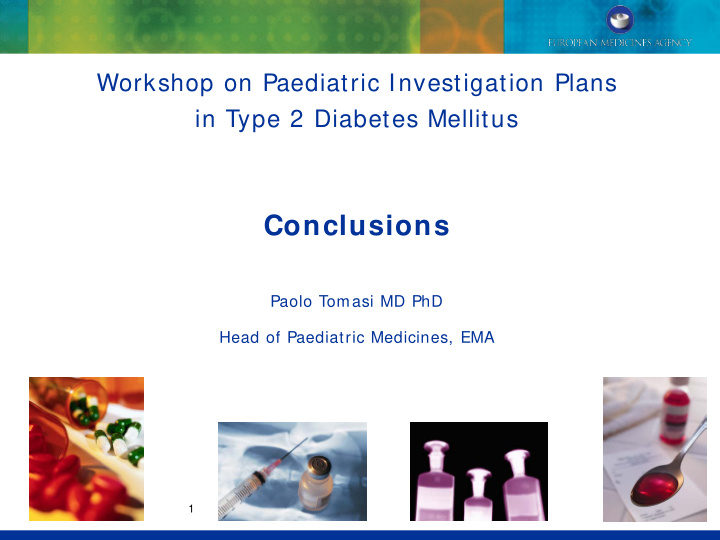



Workshop on Paediatric Investigation Plans in Type 2 Diabetes Mellitus Conclusions Paolo Tomasi MD PhD Head of Paediatric Medicines, EMA 1
NIHR Medicines for Children Research Network (MCRN) 30/33 21/23 (to-date) 45/55 12/19 31/45 1/8 0/3 industry@mcrn.org.uk - www.mcrn.org.uk
Will all Paediatric Investigation Plans be completed? Com pletion of studies under BPCA w ritten request (optional, but 80% suggested by applicant) Source: IOM report on “Safe and Effective Medicines for Children: Pediatric Studies Conducted Under BPCA and PREA”
Main concerns for pharm a com panies ( feasibility) : • Few available patients in total for all the studies. • Widespread insulin (and metformin) use needs to be addressed – weaning not always feasible. • 30% patients to be recruited in EU-like countries: difficult to achieve due to rarity in EU • Many patients do not meet HbA1c inclusion criteria 4
Potential solutions • Broadened role for extrapolation (for efficacy) / sample size reduction Use of Bayesian methods with adult priors Acceptance of lower significance levels (p= 0.07, p= 0.10) Safety study only (pre or post authorization in children?) • Studies in related diseases (prediabetes? T1DM?) • Staggered development of products (in same class) / deferrals • Broadened inclusion criteria: For insulin treatment For age (up to 22? 25?) For HbA1c range For geographical origin (non-EU) What else? • Multi-com pany study (paediatric incentive and obligations are irrespective of outcome of studies) • Single company with multiple agents • Simplification of PK studies (peak and trough levels, dried blood spots) 5
Conclusions • Number of patients required is high (and it’s a minimum number). • A change in paradigm for diabetes PIPs seems necessary, to maximize feasibility and obtain significant data. • Staggered development, followed potentially by greater extrapolation and/ or reduced requirements could be a solution. • Several of the proposed solutions may be applicable in practice. • SAWP/ CHMP needs to be included in the equation; Extrapolation working group will act as the glue (chairs of SAWP and CHMP are members). • Companies may re-consider their options (multi-company studies, modification of previously agreed PIPs… )
Recommend
More recommend